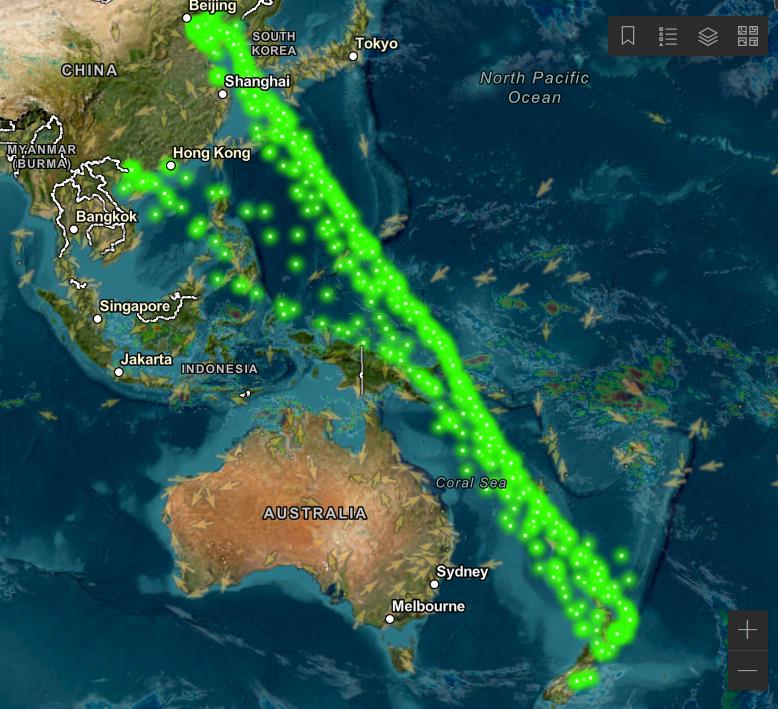

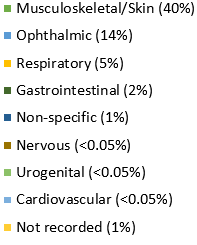
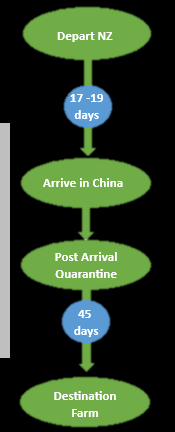

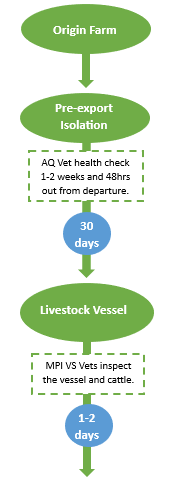

The Number and Percentage Mortalities for
Livestock Exports by Sea Continuous Improvements
Cattle Exported from New Zealand per Year
140
0.14%
Cattle by Sea Export Process
120
0.12%
alities 100
0.10%
alities
Export routes taken from Reporting Timeline
ort
80
0.08%
ort
M
60
0.06%
MPI Voyage View for all
2019
r of
40
0.04%
age M
20
0.02%
nt
vessels travelling
MPI introduced mortality
ce
umbe
ACT 1982
0
0.00%
er
N
2020
2021
2022
2023 (till April)
P
between
and post arrival reporting.
Year
Oct 2021 – April 2023
Number of mortalities
Percentage mortality
2020
*Excluding the mortalities from the Gulf Livestock 1 sinking
MPI introduced daily
Number of cattle exported from New Zealand by
reporting requirements in
October.
sea per year
160,000
134,722
134,590
140,000
2021
109,921
120,000
ttle 100,000
ca
MPI launched VoyageLink,
80,000
world first real-time app
r of
INFORMATION
reporting of animal health
60,000
40,221
39,269
umbe
and welfare at sea.
40,000
28,446
N
21,186
27,295
14,459
20,000
0
2015
2016
2017
2018
2019
2020
2021
2022
2023
(till
April)
Year
Number of Treatments by Clinical Sign
Cattle by Sea Exporters from 2019
Musculoskeletal/Skin
(40%)
s9(2)(b)(ii)
Ophthalmic (14%)
Respiratory (5%)
Gastrointestinal (2%)
Non-specific (1%)
Percentage of treatm
ents given for conditions stratified by the type of
condition being treated. Data is collected from 14 livestock transport
vessels that departed New Zealand on 44 separate voyages to China
between 8 November 2020 and 13 November 2022.
RELEASED UNDER THE OFFICIAL

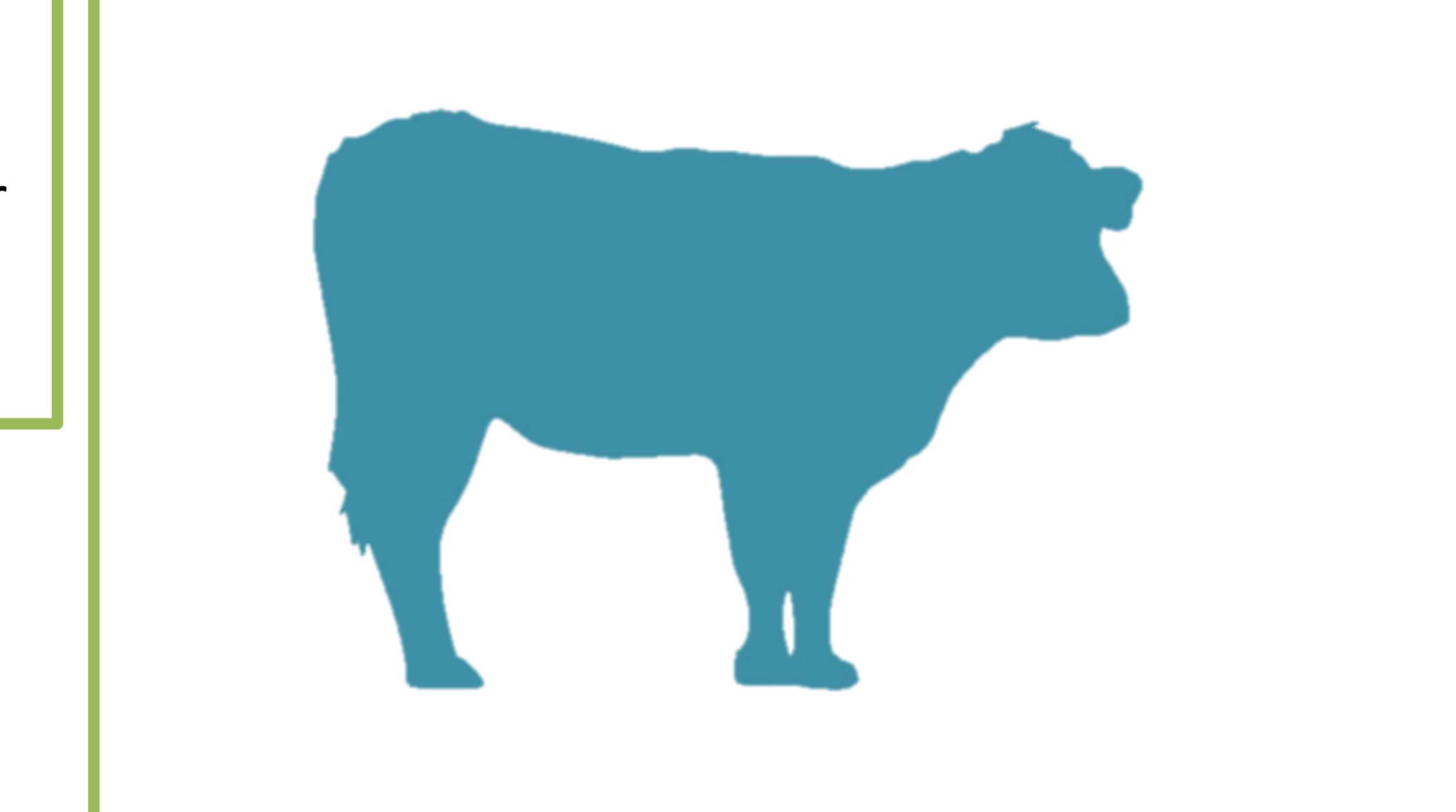



1982
ACT
s6(a)
INFORMATION
OFFICIAL
s6(a)
THE
UNDER
RELEASED
s6(a)

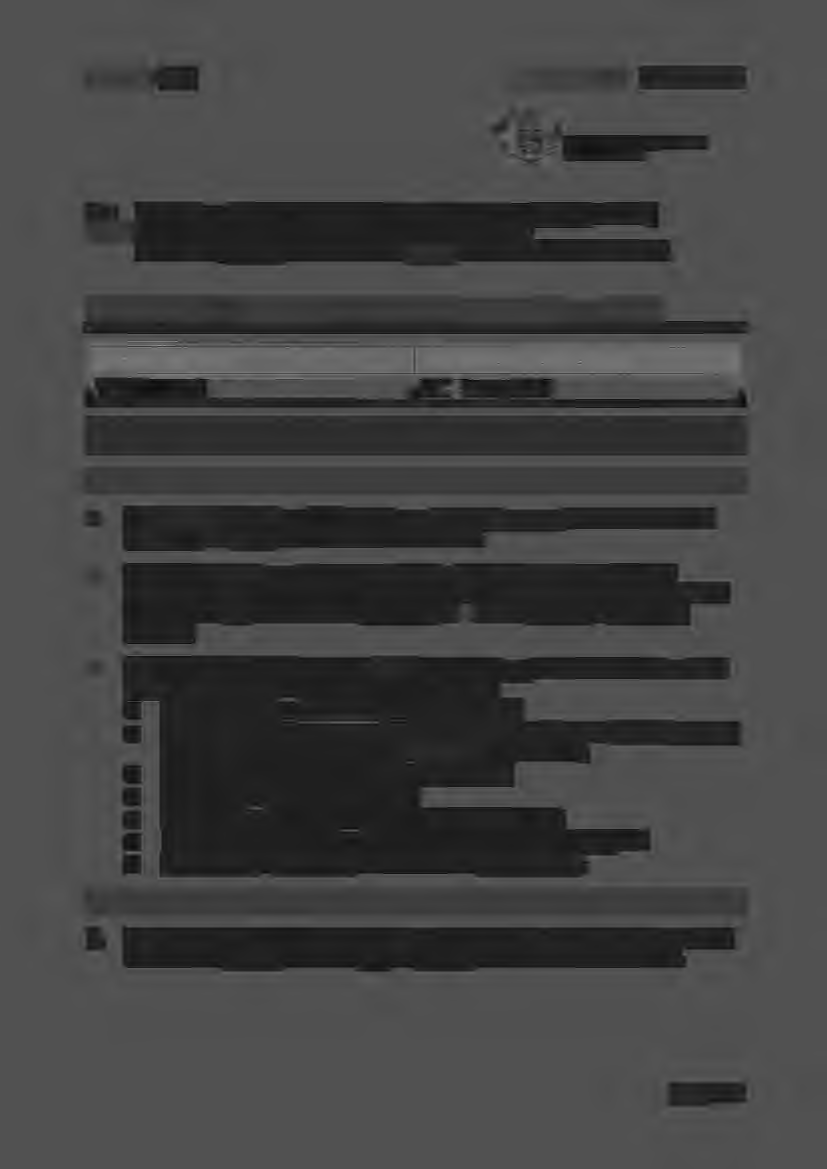


1982
ACT
INFORMATION
OFFICIAL
THE
UNDER
RELEASED
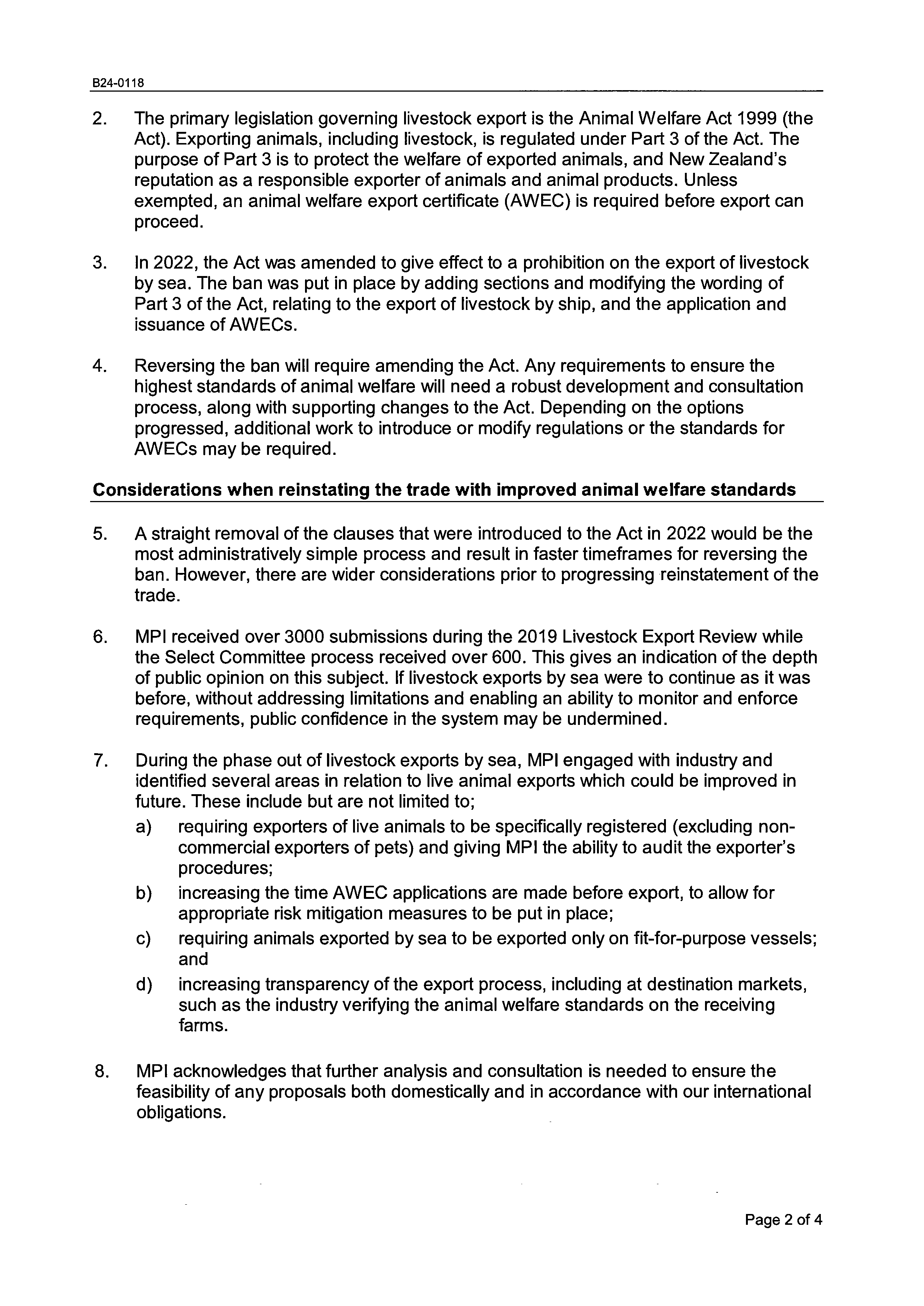
1982
ACT
INFORMATION
OFFICIAL
THE
UNDER
RELEASED
s6(a), s9(2)(j)
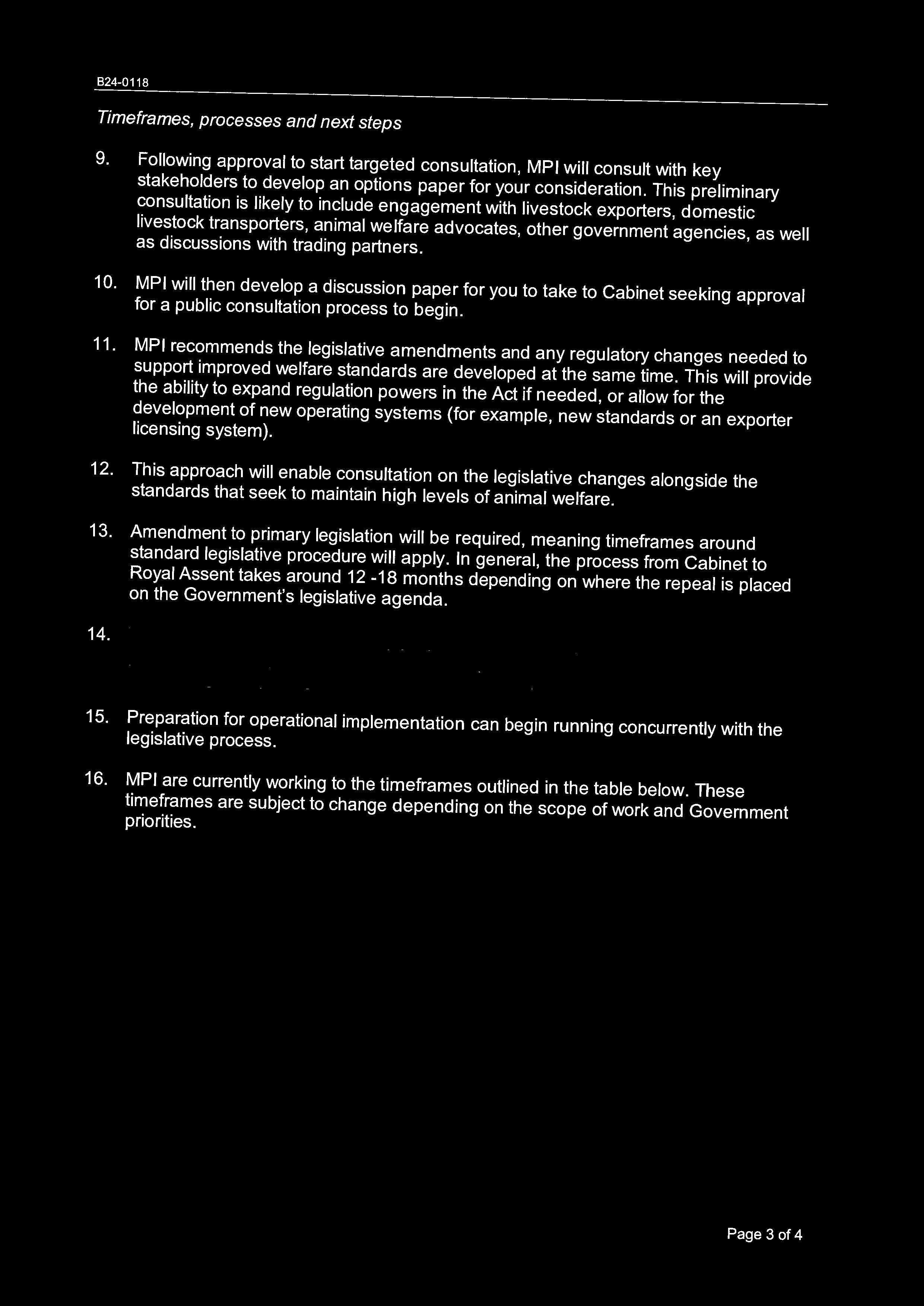

1982
ACT
INFORMATION
s9(2)(g)(i)
OFFICIAL
THE
s9(2)(f)(iv), s9(2)(g)(i)
UNDER
RELEASED
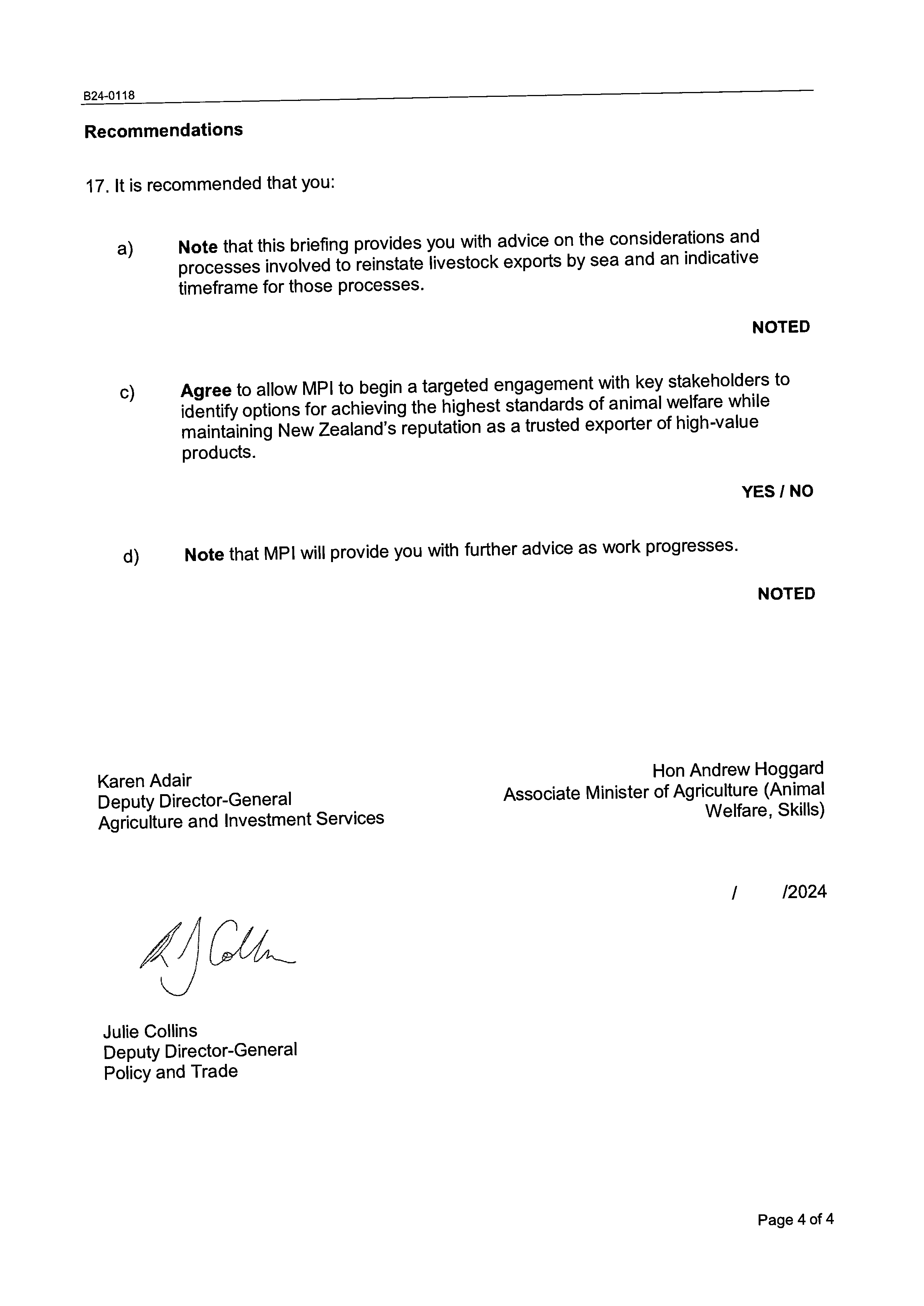

1982
ACT
INFORMATION
OFFICIAL
THE
UNDER
RELEASED

 Live Exports Ban Review Project – High Level Targeted Engagement Plan
Live Exports Ban Review Project – High Level Targeted Engagement Plan 1982
Objectives of the Initial Targeted Consultation
Proposed Initial Targeted Engagement Process
ACT
MPI is seeking stakeholder input into what the stakeholders see as the key issues when reinstating livestock exports by sea and
It is recommended that a minimum of 6 weeks will be allowed to conduct targeted consultation to provide MPI and
how this can be done in a way that is feasible and achieves the highest animal welfare standards.
key stakeholders with enough time to ensure that the options included in the discussion paper are well-thought out,
adequately described, and represent the full range of viable alternatives.
We want to identify the current issues with regulatory settings protecting welfare of animals being exported from New Zealand;
evaluate the impacts, anticipated benefits and costs of different solutions; and test whether there are alternatives that we have
Our high-level targeted engagement approach is as follows:
not yet identified that can be used to improve animal welfare during the export process.
Phase One: Develop the Plan
Scope of the Initial Targeted Consultation
Develop and approve the targeted
Develop engagement resources
Map stakeholders
engagement plan
(including the initial thoughts paper)
This targeted consultation and stakeholder plan applies from March 2024, until a
Reversing
summary of feedback is developed after the targeted engagement period
the Ban
Animal
concludes.
Welfare
Phase Two: Engage
INFORMATION
The scope will include options for reversing the prohibition of livestock exports by sea,
and include any changes to the current live animal export system that would be
NZ
Distribute engagement resources to
Carry out workshops with key
Reputation
Meet with other stakeholder groups
beneficial for animal welfare and New Zealand's international reputation. These
key stakeholders
players
changes may impact commercial exporters of species other than livestock.
Non-commercial movements of individuals transporting their pets overseas, including
assistance animals, are excluded from this scope.
Phase Three: Summarise
Live Exports Review
Summarise stakeholder feedback to inform and develop a discussion paper
OFFICIAL
Stakeholders
Stakeholders will be mapped based on their level of interest and level of influence to help MPI determine which stakeholders
Phase Two Expanded
will be a part of the initial targeted consultation.
THE
This will primarily include meeting and discussing the questions in the initial thoughts paper with our key players and
collating feedback on possible options that may be included in the final discussion paper.
This will ensure targeted consultation remains efficient and includes applicable stakeholders from the following groups:
Workshops will involve collaboration with key players and meetings will involve informing stakeholders of the project
Commercial
Recognised
Advocacy
Internal MPI
International
Stock agents
Importers
and MPI's engagement approach.
Exporters
agencies
groups
teams
organisations
Initial Contact
Provide targeted stakeholders with 'initial thoughts' paper outlining the background, purpose, scope and questions surroundin g the
UNDER
Accompanying
review and invite them to provide feedback via meetings or workshops.
Pre-export
Exporter
Group
Other
personnel
Logistics
Trading
Quarantine
employees
industry
government
(vets, stock
operators
partners
Workshops
Operators
(site vets)
organisations
departments
persons, etc)
Key players will be encouraged to attend workshops to provide feedback on the questions outlined in the initial thoughts docu ment and
collaborate on possible solutions for addressing concerns and problems.
Grouping for workshops include (please note this is not an exhaustive list):
Meetings
• Veterinarians and stockpersons that were on-board export livestock vessels
• Exporters and PEI operators for livestock, horses, and poultry
Other targeted stakeholders wil be encouraged to attend meetings where MPI will explain the project and the engagement appro ach and
•
how they can provide feedback.
Advocacy groups
• Internal MPI teams (Verification Services, Animal Welfare Policy, Animal Exports, Legal, International Trade, Market
RELEASED
Access)
• Other government agencies (Maritime NZ, MFAT)
 Priority
Priority – Medium
Security Level – In Confidence
To:
Hon Andrew Hoggard, Associate Minister of Agriculture (Animal Welfare, Skills)
From: Julie Collins, Deputy Director-General Policy & Trade
1982
Livestock Exports Work Programme Update
ACT
Date
16 May 2024
Reference
B24-0327
Decision required
Date decision required by
YES ☒ / NO ☐
27 May 2024
Purpose
•
This briefing provides you with an update on the livestock exports work programme.
INFORMATION
•
It also seeks your agreement to meet with officials to discuss the approach, scope and
desired objectives outlined in the attached draft Cabinet paper.
Background
OFFICIAL
1.
The Government coalition agreements state the intention to “reverse the recent ban
on live animal exports while ensuring the highest standards of animal welfare”.
THE
2.
The primary legislation governing live animal export is the Animal Welfare Act 1999
(the Act). Exporting animals is regulated under Part 3 of the Act. The purpose of Part 3
is to protect the welfare of exported animals and New Zealand’s reputation as a
responsible exporter of animals and animal products. Unless exempted, an animal
welfare export certificate (AWEC) is required prior to export.
UNDER
3.
In 2022, the Act was amended to give effect to a prohibition on the export of livestock
(cattle, deer, goats, and sheep) by ship. The ban was put in place by adding sections
and modifying the wording of Part 3 of the Act, relating to the export of livestock by
ship, and the application and issuance of AWECs.
4.
Progressing the Government’s coalition agreement to reverse the recent ban on live
animal exports will require amending the Act. Depending on the options identified and
RELEASED
progressed, additional work to introduce or modify regulations or the standards for
AWECs may be required. Any requirements to ensure the highest standards of animal
welfare will need a robust development and consultation process.
Page 1 of 9
B24-0327
5.
The Ministry for Primary Industries (MPI) previously provided you with background,
high level considerations and timeframes for commencing the work relating to
livestock exports by sea (B24-0118
Process for reinstating the livestock export by sea
trade refers).
Live Animal Exports Review
6.
MPI has begun work to give effect to the Government’s coalition agreements to
reverse the recent ban on live animal exports while ensuring the highest standards of
animal welfare.
1982
7.
Initial discussions have been completed with the full range of external stakeholders,
including exporters of live animals, industry and professional bodies, advocacy groups
ACT
and veterinarians who had previously accompanied livestock voyages. The outcomes
and key messages from this initial engagement are now being compiled and analysed.
8.
The initial targeted discussions were constructive with a high level of engagement
from all stakeholders. The exporters and industry participants were aware that
transparency of welfare conditions throughout the export chain will be a key issue to
address. The advocacy groups were unanimously in favour of the ban continuing. The
discussions highlighted the need to provide information to increase understanding by
stakeholders of the export process and associated welfare conditions.
INFORMATION
Scope
9.
The primary focus of this review is the export of livestock by sea. Following
conversations with your office, MPI understands that the conditional prohibition on
export of livestock for slaughter is out of scope.
OFFICIAL
10. Animal welfare concerns around the export of other live animals are likely to be raised
by stakeholders as the review progresses.
THE
11. Widening the scope presents an opportunity to address animal welfare concerns for
other commercial animal exports that currently require welfare certificates, but is likely
to be more time and resource intensive. There may be additional challenges that have
not been fully explored. s9(2)(f)(iv)
UNDER
This approach will provide a greater
understanding of any issues, how best to address these, and the implications this may
have on the current estimated timeframes around enactment.
Purpose and objectives
12. The core purpose of the livestock export review is to reinstate the ability to export
RELEASED
livestock by sea to provide a sustainable additional income generation opportunity for
farmers.
13. The review will consider:
a)
how to ensure high animal welfare standards throughout the export process;
Page 2 of 9
B24-0327
b)
New Zealand’s reputation as a responsible exporter of animals and animal
products; and
c)
New Zealand’s international trade obligations.
14. The review will be informed by public consultation on a discussion paper, which will
include potential options for reinstating livestock exports by sea. s9(2)(f)(iv)
1982
There are a number of factors to consider in relation to livestock exports
15. There is an opportunity to expand our live export potential and support the growth of
ACT
our primary industries. The animal welfare standards we impose are central to how
this will be achieved. It will incorporate balancing public assurance, animal welfare
performance, trade and reputational impacts, economic opportunities and risks, and
rural community wellbeing and success.
16. A high-level analysis of these considerations is provided below. A public consultation
process will support more detailed analysis and inform Cabinet policy decisions on the
coalition agreement.
Economic opportunities and risks
INFORMATION
17. New Zealand livestock is internationally sought after for breeding purposes (including
genetic improvements to stock) and to assist countries in developing livestock self-
sufficiency.
18. Livestock export provides additional export opportunities, an additional income source
OFFICIAL
for rural communities and are part of the broader global network of trade that benefits
New Zealand. Sale of livestock for export is generally a small, but useful income
generator across the rural sector as live animals sold for export tend to fetch a
THE
premium compared to domestic sales1. In 2022, the direct economic benefit of the
livestock export trade was valued at $374 million.
19. There are also indirect economic benefits, including demand for pre-export isolation
facilities, laboratory testing, pedigree reporting, verification services, animal transport
UNDER
and veterinary services. These services are often provided by rural communities and
are important for the rural economy. For some individual businesses, the contribution
of livestock export to their business is significant as they provide a number of services
required for the pre-export process.
20. The value the trade brings to New Zealand is largely dependent on demand in
destination countries, and New Zealand’s ability to negotiate commercially meaningful
market access.
RELEASED
1 In 2020, industry indicated that the value of a well-bred dairy crossbred heifer is around $1,500, compared
with $650 for a heifer that did not meet export specifications. Their estimate of indirect economic benefits (that
is, economic benefits beyond what farmers receive) is around $1.5 million per shipment of 3,000 animals.
Page 3 of 9
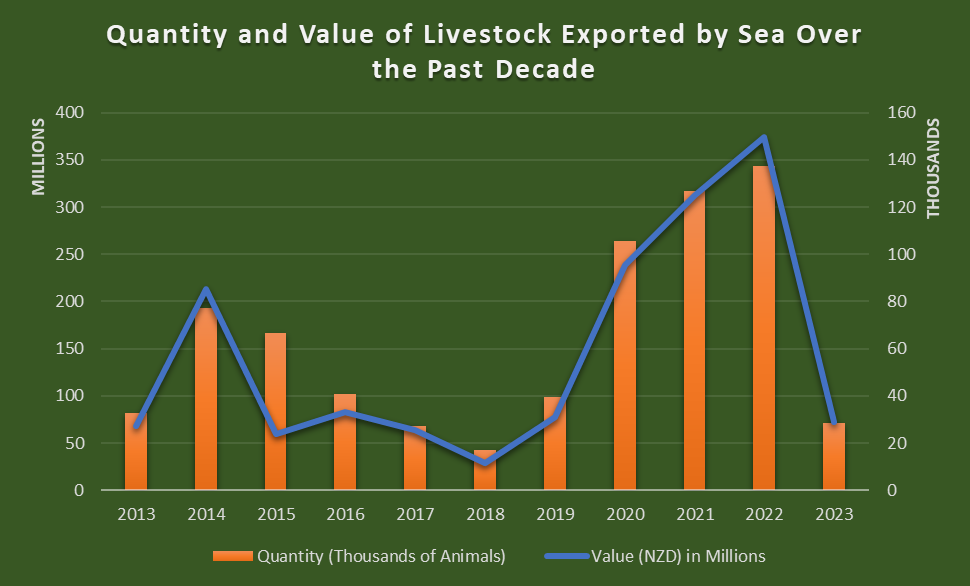


B24-0327
21. The value and volume of livestock exported by sea fluctuated in the decade before the
ban was introduced, although there was a notable increase after the previous
Government indicated it was considering the ban (see Figure 1 below).
1982
Ban of
Review of
livestock
livestock export
export
commenced
ACT
by sea
INFORMATION
Figure 1 represents the number and value (NZD) of live cattle, goat and sheep exports by sea year ending
December, from 2013-2023. Note: deer are not included as they are unable to be separated from the other not
elsewhere classified category. Source: Overseas Merchandise Trade Data, Statistics New Zealand.
22. While the increase in value and volume from 2020 may reflect increased demand, it is
OFFICIAL
unclear to what extent market demand for the period 2020 to 2023 can be used to
assume ongoing export trends. The fluctuating value of exports makes the economic
benefits of the trade difficult to quantify. There are also other economic factors to
THE
consider in the discussion of reinstating the trade. At a high level, these include:
a)
estimated demand for New Zealand livestock from overseas partners;
b)
whether supply from New Zealand has been replaced by supply from other
countries;
c)
additional costs expo
UNDER rters will need to pay to meet any new requirements; and
d)
improved trade relationships or free trade agreements (FTAs) between other
exporting/importing countries.
23. As part of reviewing the livestock export system, MPI will undertake economic analysis
to understand the potential costs and benefits of restarting the trade and introducing
any new requirements.
RELEASED
Trade and market considerations
24. New Zealand benefits significantly from the rules-based multilateral trading system
and our network of FTAs. Balancing the expectations of the public, domestic
producers, and our trading partners can be complex and will require nuanced and
clear messaging throughout the process of developing and passing legislation.
Page 4 of 9
B24-0327
25. Our reputation as a trusted producer adds value to our exports and contributes to our
standing as a responsible trading partner. Any new conditions for livestock exports
should enhance and maintain the track record New Zealand has for maintaining high
animal welfare standards.
26. s9(2)(g)(i)
1982
ACT
27. MPI will work alongside the Ministry of Foreign Affairs and Trade to ensure that
international obligations are taken into account, and that our trading partners are
informed appropriately. Final decisions will need to factor in and align with
New Zealand’s international obligations.
28. MPI will provide you with analysis on the various trade and market opportunities and
risks in a subsequent briefing.
Public assurance and reputational impacts
INFORMATION
29. Livestock exports by sea is a contentious issue that has been subject to public
scrutiny for many years2. A particular area of contention that has been raised in
previous reviews of the system is the potential reputational impacts the trade presents
to New Zealand as a responsible exporter with high animal welfare standards.
30. Stakeholders’ views on the impact of livestock export on New Zealand’s reputation are
OFFICIAL
highly polarised. Some commentators believe it harms New Zealand’s reputation,
while others see benefits in continuing to be an active participant with high standards
and influencing global practices of live animal export. MPI’s view is that reputational
THE
impacts should be considered and managed through the process of developing and
communicating the standards required for exporting live animals.
31. Regardless of any decision on whether to continue to export livestock, ongoing
advocacy against live animal export is likely to continue, within New Zealand and
UNDER
internationally.
32. These risks are important to consider but can be managed through enhancing the
regulatory framework for livestock export. While we can manage these risks through
our existing regulatory system, we cannot eliminate them completely and measures to
control outcomes beyond our jurisdiction also come with added risk.
RELEASED
33. Developing a transparent system, along with a thorough consultation process, will be
important to maintaining public confidence in the livestock export system.
2 The high number of submissions received in previous review processes and the current Parliamentary
petition of John Hellstrom (currently 35,000 signatures) indicates the depth of feeling in this subject matter.
Page 5 of 9
B24-0327
Next steps and processes
Cabinet paper informing Cabinet of the work programme
34. You asked MPI to develop a paper to inform Cabinet of the work programme to
implement the Government’s coalition agreements to reverse the recent ban on live
animal exports while ensuring the highest standards of animal welfare. A draft version
of this Cabinet paper is attached (see
Appendix One).
35. The draft Cabinet paper recently underwent departmental consultation. MPI is
1982
currently considering the comments. MPI will advise of any issues identified.
Development of a discussion document
ACT
36. MPI is preparing a discussion document with a range of options for managing welfare
of live animals for export. s9(2)(f)(iv)
Following public consultation
37. Officials will analyse submissions from the public consultation and refine options to
INFORMATION
reflect the input provided during this process. Officials will also provide you with a
summary of the submissions, and provide options for you to consider and discuss with
your colleagues. At this point you will be able to indicate if any options are considered
out of scope. Depending on the preferred options, MPI can then give a clearer
indication of timeframes to implement any proposed changes.
38. Following direction on the selected options, policy approval from Cabinet will be
OFFICIAL
required. The Parliamentary Counsel Office (PCO) will then be given drafting
instructions to draft a bill with the appropriate legislative amendments, as well as any
associated regulations required.
THE
39. Once a bill has been drafted, Cabinet approval will once again be sought to introduce
the proposed legislation to the House of Representatives.
40. Depending on the approach taken, further regulations can be developed, consulted
UNDER
on, and implemented following on from the initial legislative changes. This process can
operate concurrently during the standard legislative process.
41. MPI is currently working to the timeframes outlined in the table below. These
timeframes are subject to change depending on the scope of work, Government
priorities and resourcing requirements.
RELEASED
Page 6 of 9
B24-0327
s9(2)(f)(iv)
1982
ACT
INFORMATION
OFFICIAL
THE
UNDER
RELEASED
Page 7 of 9
B24-0327
Recommendations
42. It is recommended that you:
a)
Agree the scope of the work programme relates to the export of livestock by
sea and excludes the conditional prohibition on export of livestock for
slaughter;
YES / NO
1982
b)
Agree that alongside this work, the Ministry for Primary Industries will take the
opportunity to explore the potential for improvements to animal welfare
standards that relate to other live animal exports;
ACT
YES / NO
c)
Note that the core objective of this review is to provide a sustainable additional
income generation opportunity for farmers, while considering how to ensure
high animal welfare standards throughout the export process; New Zealand’s
reputation as a responsible exporter of animals and animal products; and
New Zealand’s international trade obligations.
NOTED
INFORMATION
d)
Note that the Ministry for Primary Industries is preparing a paper to inform
Cabinet of the work programme relating to livestock exports by sea and that the
Cabinet paper has gone out for departmental consultation;
NOTED
OFFICIAL
THE
UNDER
RELEASED
Page 8 of 9

B24-0327
e)
Note that livestock exports is a contentious subject and several considerations
need to be taken into account. You will need to consider the balance between
providing for public assurance; ensuring animal welfare standards are upheld;
diversity in economic opportunity; trade and reputational impacts; and the
needs of our rural communities;
NOTED
1982
f)
Agree to meet with officials to discuss the approach, scope and objectives
outlined in the attached Cabinet paper; and
ACT
YES / NO
g)
Agree to forward this briefing to the Minister for Agriculture and the Minister for
Trade, for his information.
YES / NO
INFORMATION
Julie Collins
Hon Andrew Hoggard
OFFICIAL
Deputy Director-General
Associate Minister of Agriculture
Policy & Trade
(Animal Welfare, Skills)
/ / 2024
THE
UNDER
RELEASED
Page 9 of 9
B24-0327
Appendix One: Draft Cabinet Paper – Live animal export review
Withheld pursuant to section 9(2)(f)(iv) of the OIA
1982
ACT
INFORMATION
OFFICIAL
THE
UNDER
RELEASED
Page 1 of 1
Appendix One
 Priority
Priority – High
Security Level – In Confidence
To:
Hon Andrew Hoggard, Associate Minister of Agriculture (Animal Welfare, Skills)
From: Fiona Duncan, Director Regulatory Systems Policy, Policy and Trade
1982
Animal Welfare: Livestock Export Review - Cabinet Paper for
Ministerial Consultation
ACT
Date
31 May 2024
Reference
B24-0060
Decision required
Date decision required by
YES ☒ / NO ☐
3 June 2024
Purpose
INFORMATION
•
This briefing provides you with a copy of the Cabinet Paper - Animal Welfare:
Livestock Export Review (the Review) and talking points.
Background
1.
You intend to take a paper to the Cabinet Economic Policy Committee (ECO) on 19
OFFICIAL
June 2024 to provide an update on the work programme to address the Government’s
coalition agreement commitments relating to livestock exports. A draft Cabinet paper
was provided to you for consideration on 16 May 2024 (B24-0327
Livestock exports
THE
work programme update refers).
2.
Following discussion with officials, minor changes have been made to the Cabinet
Paper to reflect your feedback and address matters raised during departmental
consultation. UNDER
3.
Talking points are set out in
Appendix One to support your consultation and taking of
the paper through ECO. An updated copy of the Cabinet Paper is attached as
Appendix Two.
RELEASED
Page 1 of 4
Sub24-0044
Changes have been made to update timeframes and clarify scope
4.
You met with officials on 22 May 2024 to discuss the draft Cabinet Paper and the
scope and timeframes for the work to review the livestock export system. You
confirmed:
a)
the Review is to relate only to livestock export by sea. The current prohibition for
export for slaughter is outside scope of this review and will remain in place;
b)
having an effective mechanism to set welfare standards for other animal exports
will be considered. However, only setting welfare standards for the export of 1982
livestock by sea will be part of this review;
c)
public consultation will include reversing the current ban on livestock exports by
sea, options around mechanisms to set animal export welfare standards, and
ACT
what standards for livestock export by sea should look like; and
d)
s9(2)(f)(iv)
5.
The Cabinet Paper has been updated to reflect the above.
Departmental consultation has been completed
6.
Departmental consultation on the Cabinet Paper is complete. The following
INFORMATION
government agencies were consulted: Maritime New Zealand, Ministry of Transport,
Treasury, Ministry of Foreign Affairs and Trade (MFAT), Ministry of Justice, New
Zealand Trade and Enterprise, New Zealand Customs Service, Ministry of Business,
Innovation and Employment, Ministry for the Environment, Department of Internal
Affairs, Te Puni Kokiri, and Ministry for Regulation. The Department of Prime Minister
and Cabinet (Policy Advisory Group) have been informed.
OFFICIAL
7.
No substantive changes have been made following departmental consultation. Minor
changes have been made to:
THE
a)
expand on the importance of animal welfare and strong standards as part of the
factors to be considered as the Review progresses; and
b)
include a graph showing the fluctuation of the quantity and value of livestock
exported by sea over the past decade.
UNDER
s9(2)(h)
8.
s9(2)(h)
RELEASED
Page 2 of 4
Sub24-0044
10. s9(2)(h)
1982
ACT
11. s9(2)(h)
INFORMATION
12. s9(2)(h)
OFFICIAL
13. s9(2)(h)
THE
Next steps
UNDER
14. You intend to consult with your ministerial colleagues during the week of 3 to 7 June
2024. Any changes will need to be made to the Cabinet Paper ahead of lodgement
with the Cabinet Office on Thursday, 13 June 2024.
15. Officials will consult with your office to make any alterations required to the Cabinet
Paper prior to its lodgement with the Cabinet Office.
RELEASED
Page 3 of 4

Sub24-0044
Recommendations
16. It is recommended that you:
a)
Agree that:
i.
the Livestock Export Review relates only to livestock export by sea.
The current prohibition for export for slaughter is outside scope of
the Review and will remain in place;
1982
YES / NO
ii.
having an effective mechanism to set welfare standards for other
ACT
animal exports will be considered. However, only the setting of
welfare standards for livestock export by sea will be part of the
Review;
YES / NO
iii.
public consultation will include reversing the current ban on
livestock exports by sea, options around mechanisms to set animal
export welfare standards, and what standards for livestock export by
sea should look like; and
INFORMATION
YES / NO
iv.
s9(2)(f)(iv)
OFFICIAL
YES / NO
b)
Agree to undertake Ministerial consultation of the attached Cabinet Paper:
Reviewing the Livestock Export
THE System;
YES / NO
c)
Note the Cabinet Paper, Animal Welfare: Livestock Export Review needs to be
lodged with the Cabinet Office by 13 June 2024, if it is to be considered by
UNDER
Cabinet Economic Policy Committee on 19 June 2024.
NOTED
RELEASED
Fiona Duncan
Hon Andrew Hoggard
Director Regulatory Systems Policy
Associate Minister of Agriculture (Animal
Policy and Trade
Welfare, Skills)
/ / 2024
Page 4 of 4
Sub24-0044
Appendix One: Talking Points
Livestock exports can be a valuable income generator for the rural sector
•
Live animal exports contributed $374 million to New Zealand’s economy in 2022 and
are valued by our trading partners to improve their breeding genetics and support their
food security goals.
•
The ability to export livestock by ship is historically a small, fluctuating trade, but, as it
1982
has in the past, provides another option for farmers to diversify income.
•
In 2020 industry indicated the value of a well-bred dairy crossbred heifer for export
ACT
was $1,500 compared to $650 for those that did not meet export specifications.
•
There have been no exports of livestock for slaughter since 2008. There is no
intention to change this prohibition.
•
The review will help to determine what standards are needed to ensure high animal
welfare is maintained for livestock exports by sea. Regardless of any decisions we
make, ongoing advocacy against live animal export is likely to continue, within
New Zealand and internationally.
INFORMATION
•
In the three years leading up to the ban, on average 137,000 animals were exported
from New Zealand by ship. Cattle were the most common, but one consignment of
sheep was exported in 2015.1
While livestock by ship is currently excluded, a system operates for animal exports
OFFICIAL
•
The welfare of exported animals is regulated under the Animal Welfare Act 1999. This
requires exports to have an Animal Welfare Export Certificate which can set conditions
to address animal welfare risks throughout the export process.
THE
•
Although mortality rates of this trade were low, they were not the only measure of
animal welfare performance. Other indicators of health and welfare which were also
recorded during the voyage included the behaviour cattle displayed, the feed and
water consumed, and veterinary treatments provided.
UNDER
•
The issues identified through this review will need to be carefully considered. Moving
forward, we might also need to consider whether any greater flexibility is needed to
enable welfare standards to be set in the future across the wider live animal export
system.
•
While setting animal welfare standards for export of any other animals but livestock by
RELEASED
sea is not part of this Review, having the ability to do so (if needed in the future)
supports animal welfare outcomes and enables greater assurances where needed,
helping enhance public confidence in the system.
1 That was a shipment of 45,112 sheep to Mexico. The voyage took 15 days, and 191 sheep died.
Page 1 of 2
Appendix One
Sub24-0044
How we ensure high animal welfare standards are maintained will be a key consideration
•
By enhancing animal welfare standards, I want to build political consensus on the
future of the trade, avoiding large shifts in direction with changes in Government, as
this could pose risks to our reputation as a reliable trading partner.
•
The review will consider how to ensure high animal welfare standards, while protecting
New Zealand’s reputation as a responsible exporter. This can be a tricky balance - not
setting standards high enough risks undermining public confidence, while setting them
too high risks creates barriers to market.
1982
•
Overall, this work will require us to weight assurances on animal welfare; public
ACT
confidence; diversity in economic opportunity; our international obligations; trade and
reputational impacts; and the needs of our rural communities.
•
As part of the review, the Ministry for Primary Industries (MPI) will undertake an
economic analysis to understand the potential costs and benefits of restarting the
trade and introducing any new requirements. This will include considering compliance
costs which will need to be balanced against the level of animal welfare achieved.
Our international obligations will need to be carefully considered as the Review progresses
INFORMATION
•
MPI will work alongside Ministry of Foreign Affairs and Trade to ensure trade issues
are considered, and that our trading partners are informed appropriately. Final
decisions will need to factor in and align with New Zealand’s international obligations.
This is a contentious area with very passionate stakeholders and diverse views
OFFICIAL
•
We know New Zealanders value the humane treatment of animals. Having high
animal welfare standards is important for animals, New Zealanders, and our economy.
THE
•
The impact of livestock export on New Zealand’s reputation is complex, and views are
highly polarised. Some believe it harms our reputation, while others see benefits in
having high standards and actively participating in the trade to influence global
practices of live animal export.
•
UNDER
MPI intends to work with a wide range of interested parties throughout the review. It is
currently engaging with key stakeholders to identify concerns in the live animal export
system.
•
Public consultation will provide an opportunity to better understand the diverse views
on livestock exports and the standards needed to ensure a high level of welfare when
exporting our livestock.
RELEASED
•
I intend for the discussion document to include a broad range of options and seek
input into key areas around existing animal welfare issues. I am anticipating bringing
this to Cabinet in early August to seek approval to undertake public consultation.
Page 2 of 2
Appendix One
Sub24-0044
Appendix Two: Cabinet Paper, Animal Welfare: Livestock Export Review
Withheld pursuant to section 9(2)(f)(iv) of the OIA
1982
ACT
INFORMATION
OFFICIAL
THE
UNDER
RELEASED
Page 1 of 1
Appendix Two
 Priority
Priority – Medium
Security Level – In Confidence
To:
Hon Andrew Hoggard, Associate Minister of Agriculture (Animal Welfare, Skills)
From: Karen Adair, Deputy Director-General Agriculture and Investment Services
1982
Meeting about Livestock by Sea Exports
ACT
Date 20 June 2024
Reference
AM24-0538
Purpose
•
You are meeting to discuss livestock by sea exports with (biographies in
Appendix
One):
o
Dr Helen Beattie – Managing Director, Veterinarians for Animal Welfare
Aotearoa (VAWA);
INFORMATION
o
Dr Lynn Simpson – former Australian livestock export veterinarian;
o
Dr John Hellström – former NAWAC Chair, former Chief Veterinary Officer at the
Ministry of Agriculture and Fisheries; and
o
Anonymous veterinarian – former livestock export veterinarian, submitted on the
2019 Animal Welfare Amendment Bill.
OFFICIAL
•
The meeting will take place from 4:00 pm to 4:30 pm on 24 June 2024 at
Parliamentary Library L1. THE
•
You will be supported by the following Ministry for Primary Industries (MPI) officials:
o
Dr Carolyn Guy, Director Animal Health & Welfare; and
o
Fiona Duncan, Director Regulatory Systems Policy.
•
This aide-memoire provides background information to support the meeting. Talking
UNDER
points are attached in
Appendix Two and a timeline of improvements to livestock
exports by sea is attached in
Appendix Three.
Background
1.
Dr Helen Beattie requested a meeting with you to share the attendees’ veterinary
perspectives and knowledge on the export of livestock by sea. Along with the request
RELEASED
for a meeting, Dr Beattie attached a submission on the 2019 Animal Welfare
Amendment Bill from an anonymous veterinarian.
AM24-0538
Page 1 of 3
2.
The submission outlines the veterinarian’s experience working onboard a livestock
vessel. The submission identifies heat stress and lameness as the two most
significant welfare issues observed onboard. The report details their experience with
onboard conditions, the loading and unloading process, animal handling facilities, drug
stewardship, sea conditions, ship design, leptospirosis, and trip reporting. The
submission concludes that due to the use of non-purpose-built vessels and low
transparency, the veterinarian does not support livestock being exported by sea. The
veterinarian will be in attendance at the meeting.
3.
The attendees support the ban of livestock exports by sea and are opposed to re- 1982
establishing the trade. They believe the risks to animal welfare and New Zealand’s
international reputation do not outweigh the potential benefits.
ACT
4.
MPI understands that Dr Hellström will be delivering the Protect The Ban Live Animal
Export Petition to Parliament on Tuesday 25 June at 12:15 pm. This petition has been
supported by a coalition of animal protection organisations including VAWA.
Process for the re-establishment of livestock exports by sea
5.
On 22 May, you met with officials and agreed in principle to take a proposal to Cabinet
for amending the Animal Welfare Act 1999 (the Act). The timeframe included:
a)
s9(2)(f)(iv)
INFORMATION
6.
MPI has provided you with advice (B24-0118
Process for reinstating the livestock
export by sea trade refers) on a proposed process to reinstate livestock exports by
OFFICIAL
sea, along with an indicative timeframe.
7.
MPI has undertaken targeted engagement with key stakeholders, including animal
THE
advocates and veterinarians, to identify options for achieving the highest standards of
animal welfare while maintaining New Zealand’s reputation as a trusted exporter of
high-value products. There were also separate discussions held with individual
veterinarians (at their request), who had previously worked on livestock vessels.
UNDER
Areas of improvement in the live animal export process
8.
MPI’s Continuous Improvement in Animal Exports team worked to improve a number
of areas in the welfare of export of cattle by sea leading up to the prohibition. These
areas included:
a)
ongoing review of rules and guidance, including iterative updates to the
Guidance Document: Livestock Export by Sea: Guidance for Cattle;
RELEASED
b)
a review of the Animal Welfare Export Certificates (AWEC) application process,
including increased documentation required in support of AWEC applications;
c)
inclusion of the assessment of veterinarian and stockperson experience in the
AWEC application; and
d)
improved quality of voyage reports – including daily reporting requirements, via a
software application ‘VoyageLink’.
AM24-0538
Page 2 of 3
9.
MPI has identified several other areas in the animal exports system which could be
significantly improved in the future. Amending the Act to reverse the prohibition
presents the opportunity to make improvements and establish regulations to achieve
the highest welfare standards during export.
10. Areas of improvement identified in the export process include:
a)
requiring commercial exporters of live animals to be specifically registered
(excluding owners of pets) and giving MPI the ability to audit the exporter’s
procedures;
1982
b)
increasing the time available for MPI to review AWEC applications;
c)
requiring livestock vessels to be fit-for-purpose, measured against set criteria;
and
ACT
d)
increasing transparency along the export process, including the animal welfare
standards on the receiving farms.
Minister / Minister’s Office
INFORMATION
Seen / Referred
/ / 2024
OFFICIAL
THE
UNDER
RELEASED
AM24-0538
Page 3 of 3


 Appendix One: Biographical Information
Appendix One: Biographical Information
Dr Helen Beattie
Dr Helen Beattie is Managing Director of Veterinarians for
Animal Welfare Aotearoa (VAWA). She was previously
Chief Veterinary Officer at the NZ Veterinary Association.
VAWA was established in 2022 with a stated remit to
1982
provide a science-based animal welfare advocacy voice.
VAWA membership comprises animal welfare advocates
including veterinarians, allied veterinary professionals,
ACT
animal welfare scientists, and other non-veterinary and
body corporate members. Dr Helen Beattie manages the
day-to-day operations of VAWA in consultation with an
Executive Committee.
Dr Lynn Simpson
Dr Lynn Simpson was a former Australian based on-board
veterinarian who had been employed on a number of
long-haul animal export voyages (over 57 voyages).
INFORMATION
She had further involvement of the live export chain
including pre-export preparation, stevedoring, loading live
export animals onto ships and post arrival work in
destination countries including assessing abattoirs in the
Middle East for Meat and Livestock Australia.
OFFICIAL
In 2012, she was a technical advisor with the Department
of Agriculture, the live-export industry regulator, while it
THE
carried out a review of the Australian Standards for
Exporting Livestock.
Dr John Hellström
UNDER Dr John Hellström is a former National Animal Welfare
Advisory Committee (NAWAC) Chair and former Chief
Veterinary Officer at the Ministry of Agriculture and
Fisheries from 1986 to 1991. In 2011, he was awarded the
New Zealand Order of Merit for services to biosecurity and
is largely credited with developing the concept of
biosecurity and applying it to protect New Zealand’s
ecosystem.
RELEASED
Dr Hellström is leading a parliamentary petition entitled
‘Protect the Ban on Live Export’ which, as of 14 June, has
gained nearly 45,000 signatures. This indicates significant
public interest on this subject.
AM24-0538
Page 1 of 1
Appendix One
Appendix Two: Talking Points
Livestock Exports
• I appreciate your concerns surrounding the Government’s position to reinstate the
livestock export by sea trade. The Government believes that restarting the trade is
possible, while ensuring that any shipments take place with the highest standards that
protect the welfare of the animals and uphold our international reputation as a
responsible exporter of animals.
1982
• Reinstating livestock exports by sea will require amending the Animal Welfare Act 1999.
The timing of that is yet to be determined.
ACT
• To ensure the high standards of animal welfare for animals being exported, I intend to
work with the wide range of interested parties throughout this process.
• I have asked officials at the Ministry for Primary Industries (MPI) for advice on this
matter. MPI will consult on options to reinstate the trade with improved animal welfare
standards.
• Public consultation will provide an opportunity to better understand the diverse views on
livestock exports and the standards needed to ensure a high level of welfare when
INFORMATION
exporting our livestock.
• I can assure you that our commitment to ensure the highest standards of animal welfare
will be taken into account throughout the process.
• There are several considerations that the Government must take into account alongside
OFFICIAL
animal welfare, such as the economic benefits to farmers and rural communities.
• We have a lot of work to do to ensure the highest standards of animal welfare for
THE
animals being exported and I hope that you can work with my officials during this
process.
Why is the trade being restarted?
UNDER
• The live export trade has made a valuable contribution to the New Zealand economy
and reintroducing it supports the growth of our primary industries.
• Live animal exports contributed $374 million to New Zealand’s economy in 2022 and are
valued by our trading partners to improve their breeding genetics and support their food
security goals.
• The trade provides farmers an opportunity to offload surplus livestock and diversify their
RELEASED
farm income when times are tough in the sheep and beef sector.
• As well as providing additional export opportunities, exported livestock gain premium
prices compared to domestic livestock sales.
AM24-0538
Page 1 of 2
Appendix Two
• Indirect economic benefits include demand for services in rural communities to support
the trade. These include pre-export isolation facilities, laboratory testing, pedigree
reporting, verification services, animal transport and veterinary services.
How are you going to manage the welfare risks?
• The review will include wide consultation and input from a range of interested
stakeholders and the public to ensure that world-leading animal welfare standards are in
1982
place before the trade is restarted. This includes being able to prove that animals are
well cared for both enroute and at their final destination.
ACT
INFORMATION
OFFICIAL
THE
UNDER
RELEASED
AM24-0538
Page 2 of 2
Appendix Two
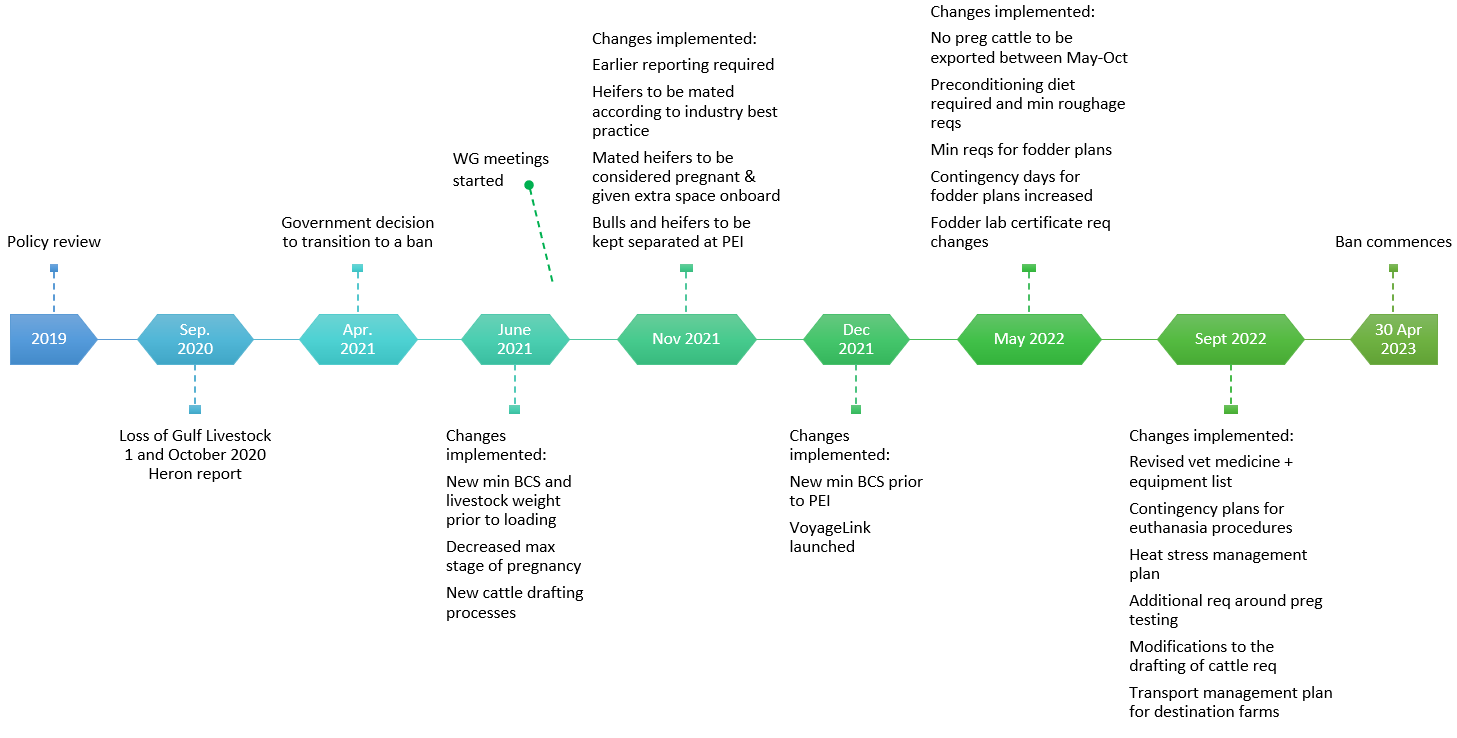 Appendix Three: Livestock exports by sea – Continuous Improvements Programme timeline
Appendix Three: Livestock exports by sea – Continuous Improvements Programme timeline
1982
ACT
INFORMATION
OFFICIAL
THE
UNDER
AM24-0538
Page 1 of 1
Appendix Three
RELEASED


































